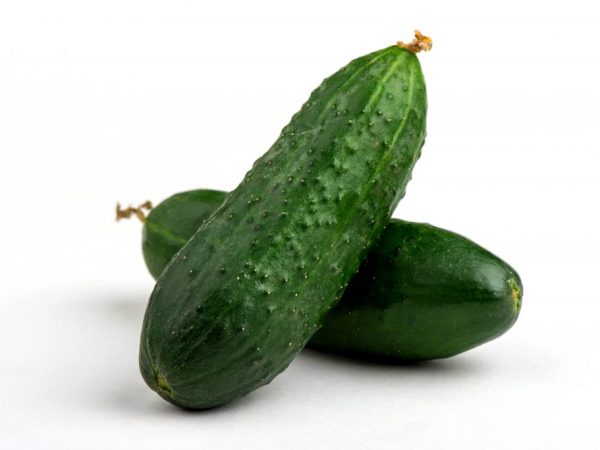Cucumber variety Sarovsky
The Sarovsky cucumber variety is a godsend for lovers of small, crispy cucumbers. The variety is early maturing, high-yielding and easy to care for.

Cucumber variety Sarovsky
The fruits have excellent taste, are suitable for raw consumption, canning, long-term storage, transportation.
Advantages and disadvantages of the variety
Cucumber Sarovskiy f1 is the most widespread variety, as there are more pluses in its cultivation than minuses.
Pros:
- early ripening variety;
- easy to clean;
- high-yielding;
- the culture is resistant to diseases and parasites.
Minuses:
- daily harvest;
- not suitable for growing on balconies, greenhouses and greenhouses.
Growing
There are two ways to land the f1. The first one - seedlings, the second - directly into the ground.
Seedling
For seedlings, F1 seeds are sown in bowls, pots or greenhouses in the second half of April - first half of May, then planted in the beds in early June. Planting step and row width 50cm, depth 4cm. Seedling cucumbers are sown in containers. If you do not have containers, you can use pots, plastic cups, special cassettes or tablets. The soil is suitable for the store or from the garden, mixed with humus. It is necessary to plant seedlings in open ground in the first decade of May. But here everything is individual - the landing time will depend on how strong the activity of the sun is and how well the soil is warmed up, if at the beginning of May it is not yet warm enough to transfer the planting to the second decade - May 10-14.
Seeds
Seeds are sown directly into the soil in the second half of May (May 15-18), when the soil is already sufficiently warmed up. The landing pattern is the same, but the depth is 2cm. Store seeds do not need to be prepared before sowing, unlike hand-picked seeds. Home seeds must first be treated with a weak solution of nitrophoska and placed in the cold for two hours for hardening.
The soil

It is important to choose the right landing site
The soil is needed light, with neutral acidity. It is advisable to prepare the place in the fall. It is better if it is sunny with a little darkening, to protect the plant from hot rays.
It is recommended to sow Sarovsky in the soil on which beans, beans, peas, tomatoes, potatoes previously grew, but after pumpkin, zucchini and garlic it is not recommended.
In autumn, the soil is cultivated and organic fertilizers are applied, about 10 liters of manure per 1 m2, in the absence of such, mineral fertilizers such as potassium salt 25 g and superphosphate 45 g. Before planting, the soil is once again dug up and fertilized with 20g of nitrate per 1m2.
When sowing seeds directly on the garden bed in the second half of May, the first half of June, it is recommended to cover the crops with foil at night.
Care
The description shows that the Sarovsky cucumber variety does not require special care. The main thing is to timely water, fertilize and loosen the soil to enrich the roots with oxygen. Weeds need to be removed regularly so that they do not harm the plant.
For good fruiting, the bush is treated with a sweet syrup that attracts bees. Spraying is best done in dry weather.
Watering
Sarovskiy F1 is watered often, with a small pressure, in order to avoid erosion of the soil on the roots. It is best if it is drip irrigation or through a spray. Watering is necessary once a day in the evening; in dry weather, watering is done twice a day, in the morning and in the evening.
Top dressing
Since the Sarov cucumber is an early ripening variety, it develops very quickly. With such an intensive growth, the plant needs organic and mineral substances. Therefore, feeding should be done regularly. For the first time, the plant is fertilized immediately before the first flowers, after which it is continued every ten days.
- For feeding, prepare the following substrate - take 10 liters of water, 1 tsp each. urea, potassium sulfate, superphosphate and 200 g of fresh manure.
- If there is no manure, then in the store you can buy any organic fertilizer and add according to the instructions.
Pest control
There are several types of pests that harm cucumbers, these include:
- melon aphid;
- spider mite;
- ants;
- slugs;
- whitefly.
For the prevention of pests, it is necessary to remove the remnants of previous plants from the site, fight weeds, disinfect the soil, and make sure that it does not dry out. It is recommended to plant dill nearby, its flowers attract ladybirds, which eat many pests. To prevent whitefly, plant tobacco.
If you failed to prevent their appearance, do not despair - there are many ways to deal with them:
- If aphids appear, you need to take 1 kg of fresh grass, insist for one day, spray or take 200 g of ash, 50 g of laundry soap, dilute in 10 liters of water.
- Tick colonies are fought with the help of an infusion of onion and garlic husks, you need to take 100 g of husk, 10 liters of water to insist for a day, and spray 5-6 times.
- Ants can be caught with syrup bottles, nests can be filled with kerosene, and the soil can be hardened with lime or ash.
- To combat slugs, you can treat the garden bed with Metaldehyde according to the instructions of the drug.
- To remove the whitefly, it is necessary to wash off the larvae from the leaves, loosen the soil and sprinkle with peat or humus, spray the plant, according to the instructions, with Inta-Vir.
Thanks to these simple rules, it is possible to grow the Sarovsky cucumber variety in various climatic conditions.


